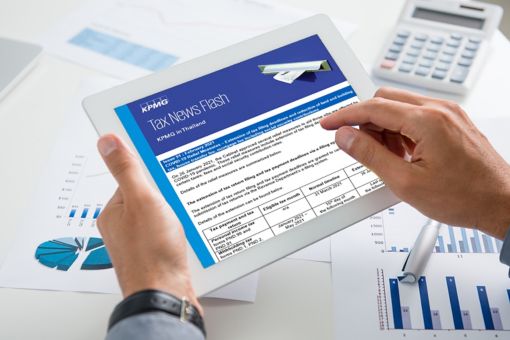The Thai Revenue Department (TRD) issued Departmental Instruction No. Paw. 164/2568 to revise the input tax allocation basis on selling goods outside Thailand by registered operators, together with examples.
For registered operators engaged in both businesses which are subject to VAT and businesses not liable to VAT under Section 77/2 of the Revenue Code:
They must first apportion the common input tax on goods/services used for both types of businesses based on the revenue proportion of the business which is not liable to VAT. The remaining input tax can then be deducted from the output tax in the VAT calculation.
Example:
- In May, Company A, a registered operator, has THB16 million in revenue from domestic sales and THB4 million from sales with contracts and deliveries made abroad (20% of total revenue).
- Company A has THB1 million in common input tax. Thus, it must first apportion 20% of the input tax (THB200,000) to the business which is not liable to VAT, and the remaining THB800,000 can be deducted from the output tax.
For registered operators engaged in (1) businesses subject to VAT, (2) businesses not subject to VAT (VAT-exempted businesses, Specific Business Tax (SBT)-liable businesses, and SBT-exempted businesses) and (3) businesses not liable to VAT under Section 77/2 of the Revenue Code:
They must first apportion common input tax on goods/services used for all three activities based on the revenue proportion of business not liable to VAT. The remaining input tax can then be allocated in accordance with Section 82/6 of the Revenue Code.
Example:
- Company B, a registered operator, exports and sells fresh chicken both domestically and internationally. In 2023, its revenue from VAT-liable exports and VAT-exempt domestic sales is split equally.
- In May 2024, Company B has THB6 million in export revenue, THB10 million in domestic sales, and THB4 million in foreign sales contracts (20% of total revenue).
- Company B has THB1 million in common input tax. Thus, it must apportion 20% (THB200,000) to business not liable to VAT first. The remaining THB800,000 is then allocated equally per the previous year's revenue ratio (50:50), allowing a deduction of THB400,000 from the output tax.
KPMG’s observations
- According to this Departmental Instruction, a VAT registered operator is required to do two steps of common input tax allocation. Initially, a VAT registered operator needs to conduct the apportionment of input tax to the business not liable to VAT. Subsequently, the remaining input tax can be allocated among businesses subject to VAT and business not subject to VAT. In addition, these two steps must be done every month in which a registered operator has income from the business not liable to VAT.
- It is strongly recommended that the taxpayers review their current VAT practices to (i) make sure that it is consistent with this new Departmental Instruction and (ii) identify non-VAT compliance areas in order to take necessary actions to manage future VAT exposure.
If you have any questions, please feel free to contact us.
Key contacts
Connect with us
- Find office locations kpmg.findOfficeLocations
- kpmg.emailUs
- Social media @ KPMG kpmg.socialMedia
Why work with KPMG in Thailand
KPMG in Thailand, with more than 2,500 professionals offering Audit and Assurance, Legal, Tax, and Advisory services, is a member firm of the KPMG global organization of independent member firms affiliated with KPMG International Limited, a private English company limited by guarantee.



